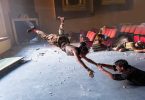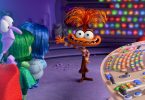In the Heights feels like a dream in every sense of the word. The core theme of the film is following one’s dreams, something every character strives to accomplish with either success or struggle. The flashy and exuberantly choreographed musical numbers feel like a dream too, with everybody perfectly in sync and dancing to the rhythm. The biggest dream, however, is seeing all these multiple facets of Latino culture represented in a big blockbuster film. In the Heights turns dreams into realities, delivering one of the best films of the year that is perfect in almost every way.
In the Latino neighborhood of Washington Heights, everyone has their own dreams they want to follow. Bodega owner Usnavi (Anthony Ramos) has dreams of moving back home to the Dominican Republic and rebuilding his family’s restaurant that was destroyed by the hurricane. Hair stylist Vanessa (Melissa Barrera) dreams of opening up her own design studio but struggles to find the means to do so when no one is willing to put their trust in her despite having the money for the initial deposit. Meanwhile, Nina (Leslie Grace) is returning home from her first year at Stanford and is having second thoughts about going back. Despite the ups and downs of their own individual dreams, one thing everyone can count on is the community they have in Washington Heights.
Hamilton may have made Lin-Manuel Miranda a household name, but In the Heights is his origin story and dare I say the strongest display of his talents. Not only is the story deeply personal, but the songs and choreographed dance numbers all drive its themes forever marching forward. There is a sense of identity in every element and character. The musical numbers have that typical Lin-Manuel Miranda rap flare, with rhymes coming at you faster than the A train. If you’re not familiar with the musical, you’ll likely need to listen to the songs a few times to get their full impact. They hit hard and fast so it’s easy for a lyric to go in one ear and immediately out the other. The songs aren’t just catchy tunes that are good for dancing too, either. They represent the hopes, dreams, and fears of the characters who sing them, and are absolutely vital to the story. When Leslie Grace’s Nina sings “Breathe” she’s singing about her internal struggle with the possibility of not going back to college and the pressures of disappointing her family and community. “96,000” slams and hits all the right notes with its upbeat representation of what everyone would do if they won the lottery. Every song hits differently and with purpose.
What I love most about In the Heights is how Latino culture is represented front and center and is not just some afterthought saved for a scene or two. There’s a moment when “Abuela” Claudia, the matriarch and rock of the entire Washington Heights neighborhood, explains how when her family immigrated to the United States they would do little, simple things like wearing velvet gloves to cover up their worked hands just to not feel invisible. It’s the little details in the film that shine. Little things like how Nina is introduced with straight hair just as she’s arriving home from college, but as soon as she’s back with the community she’s back to her naturally curly hair. It’s never brought up in dialogue or song, but that little detail says so much about her struggle with her identity and sense of community. Every character, big and small, has a full arc. They’re all chasing after their own dreams, which are not always so straightforward. Even the Piragua Guy, played by Lin-Manuel Miranda, who only appears in a few scenes gets to have a short song that speaks out about gentrification as his small shaved ice cart is being overtaken by the corporate Mister Softee. I personally connected with every character on some level, sharing their same thoughts, dreams, and fears. Having this kind of connection to characters and seeing myself represented on screen in such an intimate and passionate fashion often had me on the verge of tears.
In the Heights isn’t just a movie, it’s a movement. It’s authentic, real, and demands to be seen and heard. There’s a song in the final act where everyone is singing about being powerless. It’s lyrics have double meaning because they are literally powerless due to a blackout, but at the same time they often feel powerless and invisible in the grand scheme of things. But in truth they are powerful and always preserving, screaming from the rooftops with a determination unlike anything else. That is this film. In the Heights is a powerful wave that is impossible to ignore; a dream come true.
-
In the Heights
Summary
In the Heights feels like a dream in every sense of the word. The core theme of the film is following one’s dreams, something every character strives to accomplish with either success or struggle. The flashy and exuberantly choreographed musical numbers feel like a dream too, with everybody perfectly in sync and dancing to the rhythm. The biggest dream, however, is seeing all these multiple facets of Latino culture represented in a big blockbuster film. In the Heights turns dreams into realities, delivering one of the best films of the year that is perfect in almost every way.







